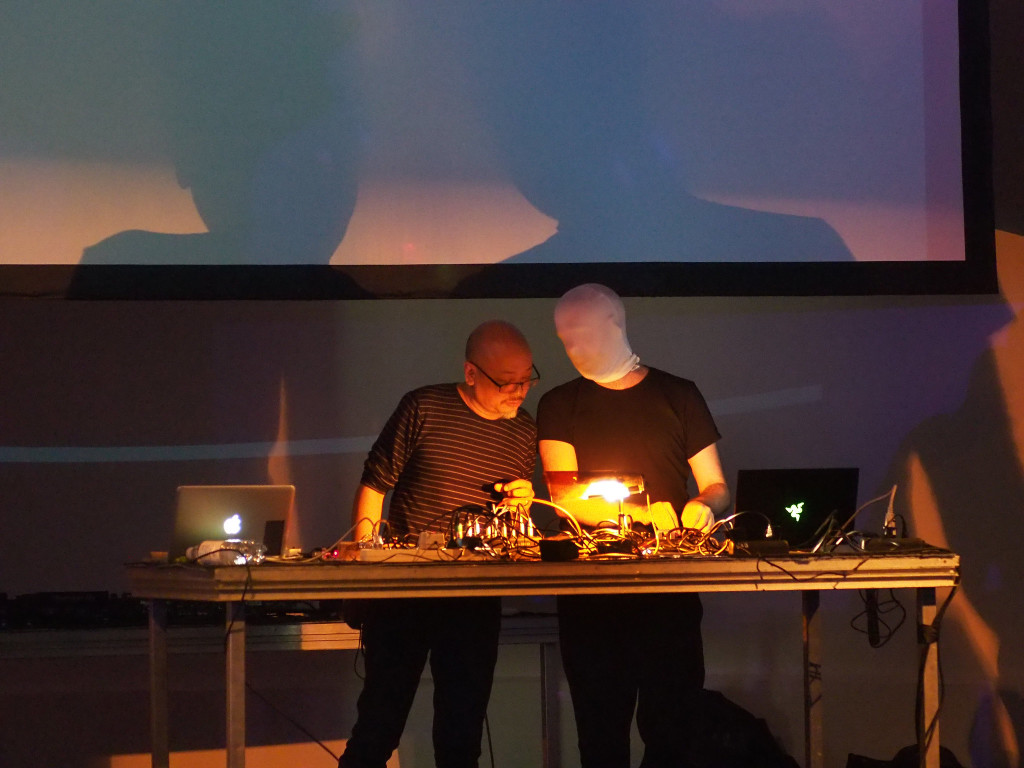We get a deep decolonialist reflection on the Philippines, music, technology, and identity from new media artist Tad Ermitaño. And yes, some larvae make music as they eat their way through a log.
Tad is a leading media artist from Manila; I got to know him through his participation in one MusicMakers Hacklab with us (Nusasonic / Yogyakarta) and co-hosting two more (Nusasonic Manila last fall, CTM Festival Berlin start of this year). That’s meant he’s made a tremendous impact on our program in both Asia and Europe, as well as playing with me at the CTM opening. But most importantly, he’s been a big part of Manila and experimentalism for decades. His apartment studio in central Manila has a room full of equipment and odds and ends and welding masks and ephemera; his imagination seems to construct strange sounds out of whatever he touches. He’s soft-spoken, but also created a violent, punk-style work with a television set in the garden art space in Java. And he’s a passionate and adventurous foodie, which is probably not entirely relevant here but – music sure is a good excuse to eat well, when we can.
Tad is uniquely reflective and thoughtful, so here we get insights not just into Filipino culture but the human condition. A good starting point is his talk in Berlin earlier this year:
William Gibson famously said: “The future is already here, it’s just not evenly distributed.” The Philippines is one of those liminal places where even modernity is unevenly distributed. It is often described as semifeudal and semicolonial, and even the capital of Manila is a place where scientific literacy coexists with religious and animist beliefs.
At the same time, it is scarred in many places by the ruthless application of technology. As a result of its particular and partial relationship with modernity, it is a country where it is possible, even urgent, to consider the possibility of an animist technology, and what uses magic might still serve.
It’s a tough time right now in the Philippines with both COVID-19 and the government – which also means Filipinos are stuck in their homes right now in an especially restrictive lockdown. But Nusasonic lives. The regionwide platform, sponsored by Goethe-Institutes in Southeast Asia, is a collaboration of Yes No Klub (Yogyakarta), WSK Festival of the Recently Possible (Manila), Playfreely/BlackKaji (Singapore), and CTM Festival for Adventurous Music & Art (Berlin). And now while we wait for travel and audiences to open again, it’s publishing articles.

Tad develops his ideas further in a must-read two-part series. I think it opens up the discussion about decolonialization into more dimensions – and reveals his awareness of navigating identities both imported and national.
It’s actually worth watching the talk and then reading the article as you hear echoes of the same ideas, but evolving. And there’s a rice cooker, and the bamboo camera makes another appearance. Under the rubric “technophobia and Filipino nationalism”.
It raises an interesting question: could nationalistic anti-colonial thoughts themselves become restrictive (and its own trap of the colonized)? Then again, maybe I can’t really know my own American culture without knowing it through a Filipino mirror (including through the USA’s extraordinary population of Filipino immigrants). From Tad’s point of view:
I remember knowing from moment to moment exactly what to hold back from saying if I didn’t want to be accused of »being American,« which was of course a synonym for being un-Filipino. It didn’t only have to do with speaking English. Talking about the physics of music was being American. Arguing in detail was being American. Even something as straightforward as asking for evidence could lead to the accusation.
Technophobia and Filipino nationalism
The Bars Of The Bahay Kubo – Part 1
Philippine identity is conceived as essentially rustic, or as I prefer to put it, »essentially low-tech.« “Essentially low-tech is half of a notion of an identity constructed in opposition to the technologically superior colonial master. The full restatement of this version of the cofradias’ image would be something like: low-tech but soulful.
The Bars Of The Bahay Kubo – Part 2
Background on this project, from Manila’s Tengal of Nusasonic (and founder of the former WSK festival):
A little update from our platform NUSASONIC after a long hiatus, not knowing what to do with the platform as COVID Pandemic hit the world, each of us curators struggle on daily survival, even one of us got stranded in Myanmar for 3 months during a research trip (Joee Mejias) — but we’re pleased to announce that NUSASONIC has released the first article on our online magazine.
“In the realm of art at least, almost all confessions of unfamiliarity with a technical matter were inevitably accompanied by a rhetorical move to negate the technical, to dismiss it as unimportant or misguided.”
We’re very honored to have Tad Ermitano to write our very first original article on Nusasonic Magazine. Tad Ermitaño himself is a key figure in new media art in the Philippines and Southeast Asia, with a history reaching as far back as the late 80s when he co-founded the media collective Children of Cathode Ray. His artistic practice has grown into an examination of the processes, semiotics, and structures surrounding man’s relationship with machinery.
Here’s an audio conversation from way back in 2013, to catch our friends in a much earlier era of the WSK Festival. Keeping the faith for what may be next.
More to say about Tad and more to hear. Hope your San Miguel stock miraculously lasts and stays cold and that your freedom is back soon.
Photo at top by Eunice Maurice, at Wayang Ukur.